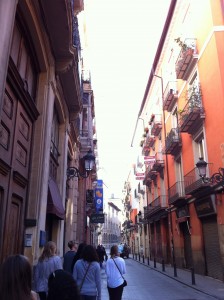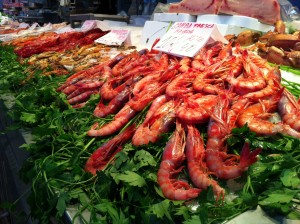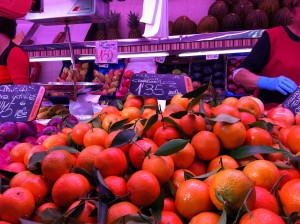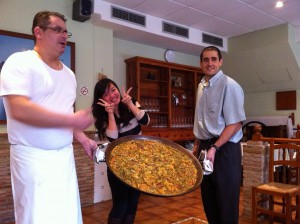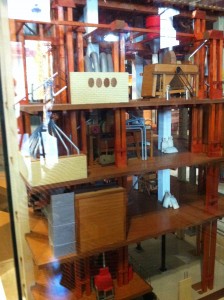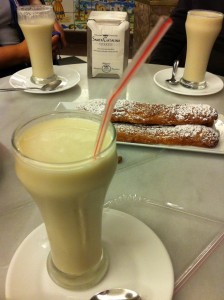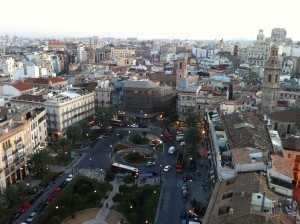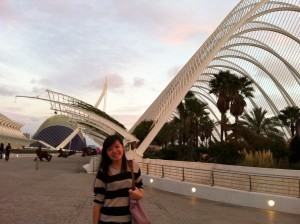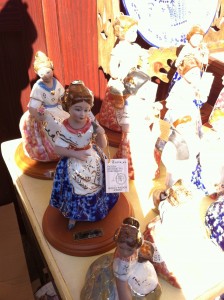
A statue of a girl wearing the traditional dress of Valencia - very different from the traditional Flamenco dress in Sevilla and Andalucia
During almost four months in Spain, I have been to a lot of places but I did not realize that all the places I have been to in Spain are all in Andalucía, one of the autonomous communities. Every city has its own beauty but they all share the same culture, the churches, the cathedral, the Flamenco, everything you can imagine about a typical Spain. This weekend I went with my interest group in CIEE to Valencia – the third largest city in Spain and also the capital of the autonomous community of Valencia and had a chance to open up my eyes a little more to see Spain outside of Andalucía.
Sevilla is the fourth biggest city in Spain, right after Valencia but to me Valencia seems a lot bigger. Valencia is a lot more modern with wider roads, taller buildings and everything is lit up brightly later at night. We had a tour guide from Valencia to show us around. She took us for a walk through the major parts of the central of the city and our first stop was the central market and not the cathedral like most other cities in Andalucía. There were actually two markets; one of them, called the “Lonja” used to be the central market in the old days but has been out of business and now preserved to be a tourist site. Considering the need for the market of people in Valencia, another was open right in front of the old one. Here everything regarding food is sold, from fresh seafood, fresh meat, fresh vegetables, to dried fruits and authentic Greek cuisine.
As I might have mentioned in some other article, people in Valencia are the only in Spain who eat rice everyday instead of bread and their rice is well known in Spain. “Paella” is a very famous rice dish in Spain that originates from Valencia, and as a group whose interest is on food, we paid a visit to the rice fields in the suburb of Valencia, a rice museum and went to taste the original “paella.” Valencia was where the Moors first brought rice to Spain in the end of the eighth century and since then rice has been an important part in the life of people living in Valencia. “Paella” is cooked in a typical round pan called “paellera” and because “paella” can only be cooked in that one type of pan, its sizes vary depending on the number of servings. As a result, a paella pan size can range from 10-inch to 40-inch in diameter. Everywhere else in Spain, “paella” is cooked with various types of seafood, meat and vegetables. The original “paella,” however, is made either with fish and vegetables or chicken and vegetables and never a mixture of fish, meat and vegetables.
Valencia is also famous for a drink called “Horchata.” “Horchata” can be found in some Mexican restaurants in the States but it is made from different ingredient. “Horchata” from Mexican restaurants from the States is made from rice whereas Valencia “Horchata” is made from a type of plant called “chufa” (in English – earth almond). According to people in Valencia, when the Crown of Aragon came to conquer Valencia, a maid gave him this drink that she called the milk of “chufa.” The Crown likes the drink a lot and says: “Esto no es leche, esto es oro, guapa!” (translated as “this is not milk, it is gold, beautiful!”). With the dialect from Valencia, “oro, guapa” is pronounced as “or”, “xata” and people later called it “orxata”, or “horchata”.
Beside the official Spanish language, also called Castellano, people in Valencia speak Valenciano. To me and from what I have heard from other people, Valenciano seems to be a lot similar to Catalan – the dialect spoken in Catalonia – another autonomous community in Spain where Barcelona is the capital. People from Valencia, however, like to think that it is their own language and this is not something that could be widely discussed in Valencia.
